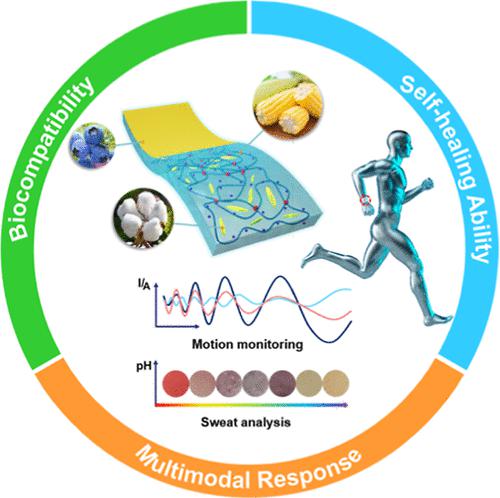当前位置:
X-MOL 学术
›
Chem. Mater.
›
论文详情
Our official English website, www.x-mol.net, welcomes your
feedback! (Note: you will need to create a separate account there.)
Self-Healing Bimodal Sensors Based on Bioderived Polymerizable Deep Eutectic Solvent Ionic Elastomers
Chemistry of Materials ( IF 7.2 ) Pub Date : 2022-11-28 , DOI: 10.1021/acs.chemmater.2c03105 Qinke Cui 1 , Xin Huang 1 , Xiangyu Dong 2 , Huaiyu Zhao 1 , Xuehui Liu 3 , Xinxing Zhang 1
Chemistry of Materials ( IF 7.2 ) Pub Date : 2022-11-28 , DOI: 10.1021/acs.chemmater.2c03105 Qinke Cui 1 , Xin Huang 1 , Xiangyu Dong 2 , Huaiyu Zhao 1 , Xuehui Liu 3 , Xinxing Zhang 1
Affiliation

|
Despite the remarkable progress in electronic skins (e-skins), it remains a great challenge to achieve high biocompatibility, multimodal response, and self-healing abilities simultaneously. Here, a fully biobased self-healing bimodal sensor based on the polymerizable deep eutectic solvent (PDES) ionic elastomer is elaborately constructed for skin-contact multifunctional e-skin applications. Utilizing the synergistic regulation of physical and hydrogen bonding networks constructed by the polydopamine-coated cellulose nanocrystal, the bioderived PDES breaks the limitations of general biobased materials in strength and toughness while possessing excellent self-healing properties. The resulting ionic elastomer exhibits outstanding biocompatibility (cell viability over 87%), excellent autonomous self-healing efficiency (>90%), and superior mechanical properties (2.95 and 69.57 times higher tensile strength and toughness than pure bioderived PDES). Furthermore, intrinsic ionic migration within the PDES and the pH-responsive property of the anthocyanin coating enable the sensor to bimodally detect human motion and sweat physiological information visualization, with a stable electrical output signal and a wide sweat visualization range (pH 3–12) both before and after self-healing. This work provides new perspectives for the future skin-contact and implantable bioelectronics in medical diagnostics and healthcare.
中文翻译:

基于生物衍生可聚合低共熔溶剂离子弹性体的自修复双峰传感器
尽管电子皮肤(e-skins)取得了显着进步,但同时实现高生物相容性、多模式响应和自我修复能力仍然是一个巨大的挑战。在这里,精心构建了一种基于可聚合低共熔溶剂 (PDES) 离子弹性体的完全生物基自愈双峰传感器,用于皮肤接触多功能电子皮肤应用。利用聚多巴胺包覆的纤维素纳米晶构建的物理和氢键网络的协同调节,生物衍生的PDES打破了一般生物基材料在强度和韧性方面的局限性,同时具有优异的自修复性能。由此产生的离子弹性体具有出色的生物相容性(细胞活力超过 87%)、出色的自主自愈效率(>90%)、和卓越的机械性能(拉伸强度和韧性比纯生物衍生 PDES 高 2.95 和 69.57 倍)。此外,PDES 内的固有离子迁移和花青素涂层的 pH 响应特性使传感器能够双峰检测人体运动和汗液生理信息可视化,具有稳定的电输出信号和宽汗液可视化范围(pH 3-12)自我修复之前和之后。这项工作为未来医学诊断和医疗保健中的皮肤接触和植入式生物电子学提供了新的视角。PDES 内的固有离子迁移和花青素涂层的 pH 响应特性使传感器能够双峰检测人体运动和汗液生理信息可视化,具有稳定的电输出信号和较宽的汗液可视化范围(pH 3-12)并且在自愈之后。这项工作为未来医学诊断和医疗保健中的皮肤接触和植入式生物电子学提供了新的视角。PDES 内的固有离子迁移和花青素涂层的 pH 响应特性使传感器能够双峰检测人体运动和汗液生理信息可视化,具有稳定的电输出信号和较宽的汗液可视化范围(pH 3-12)并且在自愈之后。这项工作为未来医学诊断和医疗保健中的皮肤接触和植入式生物电子学提供了新的视角。
更新日期:2022-11-28
中文翻译:

基于生物衍生可聚合低共熔溶剂离子弹性体的自修复双峰传感器
尽管电子皮肤(e-skins)取得了显着进步,但同时实现高生物相容性、多模式响应和自我修复能力仍然是一个巨大的挑战。在这里,精心构建了一种基于可聚合低共熔溶剂 (PDES) 离子弹性体的完全生物基自愈双峰传感器,用于皮肤接触多功能电子皮肤应用。利用聚多巴胺包覆的纤维素纳米晶构建的物理和氢键网络的协同调节,生物衍生的PDES打破了一般生物基材料在强度和韧性方面的局限性,同时具有优异的自修复性能。由此产生的离子弹性体具有出色的生物相容性(细胞活力超过 87%)、出色的自主自愈效率(>90%)、和卓越的机械性能(拉伸强度和韧性比纯生物衍生 PDES 高 2.95 和 69.57 倍)。此外,PDES 内的固有离子迁移和花青素涂层的 pH 响应特性使传感器能够双峰检测人体运动和汗液生理信息可视化,具有稳定的电输出信号和宽汗液可视化范围(pH 3-12)自我修复之前和之后。这项工作为未来医学诊断和医疗保健中的皮肤接触和植入式生物电子学提供了新的视角。PDES 内的固有离子迁移和花青素涂层的 pH 响应特性使传感器能够双峰检测人体运动和汗液生理信息可视化,具有稳定的电输出信号和较宽的汗液可视化范围(pH 3-12)并且在自愈之后。这项工作为未来医学诊断和医疗保健中的皮肤接触和植入式生物电子学提供了新的视角。PDES 内的固有离子迁移和花青素涂层的 pH 响应特性使传感器能够双峰检测人体运动和汗液生理信息可视化,具有稳定的电输出信号和较宽的汗液可视化范围(pH 3-12)并且在自愈之后。这项工作为未来医学诊断和医疗保健中的皮肤接触和植入式生物电子学提供了新的视角。











































 京公网安备 11010802027423号
京公网安备 11010802027423号